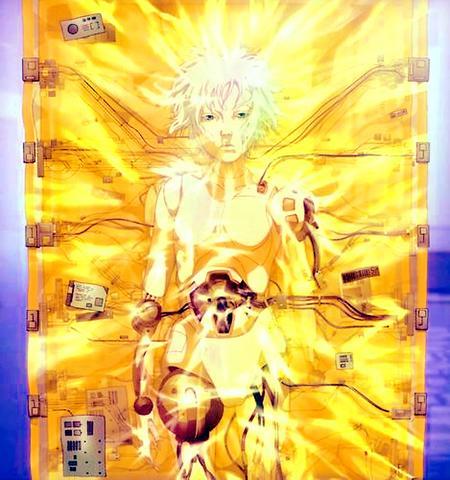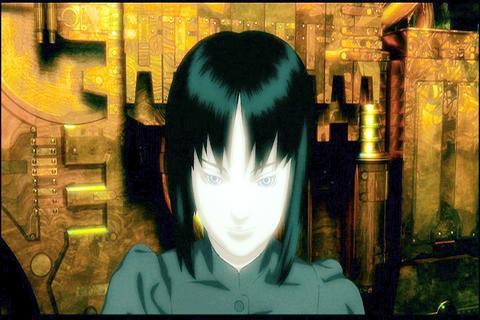Androids don't dream of electric sheep in Mamoru Oshii's hallucinatory meditation on life in the shadow of the machine world, Ghost in the Shell 2: Innocence. They dream of suicide, an unlikely act of violence that one android, or gynoid, a sexual pet with a tragic face and luridly flexible limbs, commits by clawing at its synthetic skin like a grieving widow.
In this plaintive, often stunningly beautiful anime, where sex dolls commit virtual seppuku against a swirl of film noir intrigue, philosophical speculation, eye-popping images and serious science-fiction cool, a toxic cloud hangs over all tomorrow's parties.

Written and directed by Oshii, the movie, which opens in Taiwan today, is a sequel to the Japanese filmmaker's 1995 anime, Ghost in the Shell, about a female detective who inhabits and then loses her artificial body.

PHOTOS COURTESY OF CROWN FILMS
Set in 2032, the new anime centers on her former colleague, the stone-faced cyborg Batou, a male cop in an unnamed government's antiterrorist division.
Called in to dispatch a gynoid gone amok, Batou enters with a ready gun and, in a photo-realist alley so authentically derelict that it's a surprise you can't smell it, comes face to face with a doll dressed in a peek-a-boo red kimono and a white gardenia. Push comes to catastrophic shove and, in time, what emerges is the familiar future-shock scenario in which machines seem more human than their human masters.
A study in earth tones and gum-shoe rectitude, Batou is a self-conscious cross between the detective played by Harrison Ford in Blade Runner and the runaway android played by Rutger Hauer. Drawn along the same solid lines as Hauer, Bateau comes clad in the classic world-weariness worn by Ford, one difference being that Oshii's tough guy keeps a basset hound. A floppy bundle of love and slobber, the dog is a link to the ghost (human identity) in Batou's machinery and, perhaps, as the hagiographic images of the hound suggest, something else.
Oshii squeezes charming laughs from Batou's relationship with the dog, but the hound's more essential function is to circle the film back to the fundamental question of what makes us human. Like Sean Young's replicant did with Ford's blade runner, the dog humanizes the hero and becomes the occasion for some philosophical riffing.
Although Oshii doesn't try to answer the question of existence, in between plot points that take Batou from a forensics lab to a yakuza den and rapacious doll company called Locus Solus (Latin for a solitary place), the filmmaker tosses in quotations from Descartes and Milton, nods to Jakob Grimm, Isaac Asimov and Jean-Luc Godard, lines from Psalm 139 and, most startlingly, references to the German artist and Surrealist fellow traveler, Hans Bellmer.
Inspired by Tales of Hoffman, Jacques Offenbach's opera about an automaton, Bellmer began constructing, then photographing, his fetishistic ball-joint dolls in the early 1930s. Machine-made rather than handcrafted, the dolls in Innocence are more streamlined than Bellmer's and significantly less perverse, but their ball-joints construction gives them a similar off-kilter, disturbing physiognomy.
The dolls in Innocence have bodies as bendable as that of a G.I. Joe toy, having been designed for sexual pleasure, while their faces remain frozen in Barbie-like supplication. Like many artists, Oshii clearly derives enjoyment from the image of the female form in all its mutations, but in this film that delight also comes with a little politics. Unlike Bellmer's dolls, Oshii's dolls sever their bonds and the occasional male head.
The bumps may be a function of the translation; whatever the case, they do nothing to diminish the delights of this exquisitely textured film. A seamless blend of old and new animation techniques, with the characters rendered in traditional 2D and the backgrounds in vivid 3D (computer generated imagery), Innocence doesn't just reveal a wealth of visual enchantments; it restates the case that there can and should be more to feature-length animations than cheap jokes, bathos and pandering. It also proves the point that 2D animation remains a vital technology.
But never mind the techno-babble. What matters most here isn't the number of gigabytes it took to make the feathers on a seagull look palpably real. It's the way the camera narrows in on the bird's eye as if Oshii believed the answers to the film's questions might be found in the natural world and its brutalized remnants, in that solitary place beyond the machines.
In one of the film's most hypnotically lovely set pieces, a kaleidoscopic cavalcade featuring enormous animal effigies, grimacing warriors and shimmering golden pagodas, he also suggests that the past may offer up yet other answers. In Innocence past and present, ghost and machine jostle alongside one another, while the mysteries of the universe, seen in the swirl of cream in a cup of coffee and spirals of flying gulls, continue.

Jan. 5 to Jan. 11 Of the more than 3,000km of sugar railway that once criss-crossed central and southern Taiwan, just 16.1km remain in operation today. By the time Dafydd Fell began photographing the network in earnest in 1994, it was already well past its heyday. The system had been significantly cut back, leaving behind abandoned stations, rusting rolling stock and crumbling facilities. This reduction continued during the five years of his documentation, adding urgency to his task. As passenger services had already ceased by then, Fell had to wait for the sugarcane harvest season each year, which typically ran from

It’s a good thing that 2025 is over. Yes, I fully expect we will look back on the year with nostalgia, once we have experienced this year and 2027. Traditionally at New Years much discourse is devoted to discussing what happened the previous year. Let’s have a look at what didn’t happen. Many bad things did not happen. The People’s Republic of China (PRC) did not attack Taiwan. We didn’t have a massive, destructive earthquake or drought. We didn’t have a major human pandemic. No widespread unemployment or other destructive social events. Nothing serious was done about Taiwan’s swelling birth rate catastrophe.

Words of the Year are not just interesting, they are telling. They are language and attitude barometers that measure what a country sees as important. The trending vocabulary around AI last year reveals a stark divergence in what each society notices and responds to the technological shift. For the Anglosphere it’s fatigue. For China it’s ambition. For Taiwan, it’s pragmatic vigilance. In Taiwan’s annual “representative character” vote, “recall” (罷) took the top spot with over 15,000 votes, followed closely by “scam” (詐). While “recall” speaks to the island’s partisan deadlock — a year defined by legislative recall campaigns and a public exhausted

In the 2010s, the Communist Party of China (CCP) began cracking down on Christian churches. Media reports said at the time that various versions of Protestant Christianity were likely the fastest growing religions in the People’s Republic of China (PRC). The crackdown was part of a campaign that in turn was part of a larger movement to bring religion under party control. For the Protestant churches, “the government’s aim has been to force all churches into the state-controlled organization,” according to a 2023 article in Christianity Today. That piece was centered on Wang Yi (王怡), the fiery, charismatic pastor of the